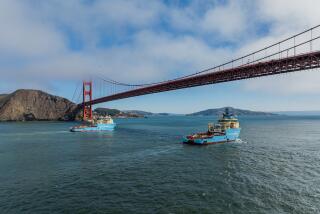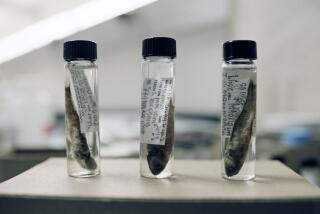Researchers find plastic in more than 9% of fish in northern Pacific Ocean
- Share via
Southern California researchers found plastic in nearly 1 in 10 small fish collected in the Pacific Ocean in the latest study to call attention to floating marine debris entering the food chain.
The study published this week by scientists at the Scripps Institution of Oceanography at UC San Diego estimated that fish in the middle depths of the northern Pacific Ocean are ingesting as much as 24,000 tons of plastic each year.
Although the research found a lower percentage of plastic-fouled fish than previous studies, it is the latest to quantify how many fish are eating marine garbage — most of it confetti-sized flecks of discarded plastic — that has accumulated in vast, slow-moving ocean currents known as gyres.
The results came from a 2009 voyage a group of graduate students made to the so-called Pacific Garbage Patch, an area with a high concentration of fragments of floating garbage about 1,000 miles off the California coast. Researchers cast nets into the water and collected 141 fish, mostly lanternfish measuring just a few inches, and took them to a laboratory in San Diego to dissect.
Scientists found plastic debris in 9.2% of their stomachs, much of it broken down into multicolored fragments smaller than a human fingernail. However, they believe the actual proportion of fish that have consumed plastic is significantly higher.
“We can’t tell how many fish ate plastic and died, how many fish ate plastic and regurgitate it or passed it out of their intestines,” said Rebecca Asch, a Scripps doctoral candidate in biological oceanography and one of the study’s authors.
Because lanternfish are a common food source for larger fish, the study raises concerns that the plastics and pollutants they ingest could make their way up the food chain into seafood eaten by humans.
Scripps found a lower rate of plastic ingestion than previous research, such as a study by the Algalita Marine Research Foundation that found plastic in the stomachs of 35% of fish in the same general area of the Pacific.
Past studies may have been inflated by keeping nets in the water for longer periods of time, giving fish the chance to eat bits of plastic swept up in the nets with them, Scripps scientists said. In their study, the Scripps researchers tried to minimize that by towing their net only 15 minutes at a time. But they stressed that their study broadly concludes the same thing: Garbage is present in the food chain.
“We’re still finding a substantial amount of plastic,” Asch said. “It should be zero.”
More to Read
Sign up for Essential California
The most important California stories and recommendations in your inbox every morning.
You may occasionally receive promotional content from the Los Angeles Times.











